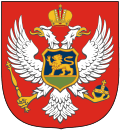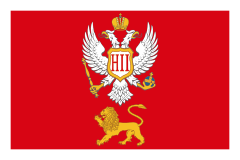Nicholas, Crown Prince of Montenegro
| Nicholas Petrović-Njegoš | |||||
|---|---|---|---|---|---|
| Crown Prince of Montenegro | |||||
.jpg) Nicholas in May 1990 | |||||
| Head of the House of Petrović-Njegoš | |||||
| Period | 24 March 1986 – present | ||||
| Predecessor | Michael, Prince of Montenegro | ||||
| Heir apparent | Boris, Hereditary Prince of Montenegro | ||||
| Born |
7 July 1944 Saint-Nicolas-du-Pélem, France | ||||
| Spouse |
Francine Navarro (m. 1976 – 2008; her death) | ||||
| Issue |
Princess Altinaï Boris, Hereditary Prince of Montenegro | ||||
| |||||
| House | Petrović-Njegoš | ||||
| Father | Michael, Prince of Montenegro | ||||
| Mother | Geneviève Prigent | ||||
| Signature |
 | ||||
| Montenegrin royal family |
|---|
 |
|
Crown Prince Nicholas of Montenegro (Montenegrin: Никола Петровић-Његош / Nikola Petrović-Njegoš; born 7 July 1944), is the Head of the House of Petrović-Njegoš, which reigned over Montenegro from 1696 to 1766 and again from 1782 to 1918.
In 2011 Montenegro recognised an official role for the Royal House of Petrović-Njegoš in Montenegro: to promote Montenegrin identity, culture and traditions through cultural, humanitarian and other non-political activities.[1] Beside protocol functions, he also shares some political powers like the President of Montenegro, such as giving amnesty to prisoners.
Family background
The house of Petrović came originally from Herzegovina and settled in Njeguši around 1400. Niegosch was born around 1425 and became the Voivode of Njegoš.
Crown Prince Nicholas descends from Danilo Petrović-Njegoš who obtained the hereditary Dignity of Vladika (Prince-Bishop) of Montenegro in 1711 when it became a theocracy. Danilo I Petrović-Njegoš was recognized as Sovereign Prince of Montenegro by Russia on 21 March 1852, and established succession by male primogeniture. His successor, Prince Nikola I assumed the style of Royal Highness on 19 December 1900, and the title of King 28 August 1910.
Nikola is also related to the former royal House of Obrenović through Yephrem, younger full brother of Miloš Obrenović I, Prince of Serbia.
During World War I the Petrović Njegoš family were forced to flee the country in 1915 after the Army of Montenegro was overwhelmed by the troops of the Austro-Hungarian Empire. At the end of the war, the Kingdom of Serbia annexed Montenegro while abolishing the Kingdom of Montenegro and deposing the Petrović Njegoš dynasty.
The family made their home in France where Nikola I of Montenegro died in exile in 1921. The same year, King Nikola's maternal grandson, Alexandar Karađorđević (Prince Nikola I's cousin) became king of the Kingdom of Serbs, Croats and Slovenes, of which Montenegro had become a part. Though the Kingdom of the Serbs, Croats and Slovenes was proclaimed on 13 November 1918, it was never recognized by Nikola I, who maintained a government-in-exile, which was headed by the ex-king's former aide-de-camp and ambassador to Washington, General Anto Gvozdenović, until the Conference of Ambassadors at Paris gave international recognition to the union 13 July 1922.
Nikola I's heir at death was his eldest son, Crown Prince Danilo (titular King Danilo II), who "abdicated" after one week, and the family's dynastic claim was taken up by his grandson, Michael, Prince of Montenegro, the titular King Mihajlo I, who was the father of Prince Nikola II and died in exile in 1986.
Though Prince Nikola II is de jure King of Montenegro he uses the style of "His Royal Highness Crown Prince" or "His Royal Highness Prince Nikola II of Montenegro."[2]
Biography
Prince Nikola II was born in an internment camp in Occupied Czechoslovakia on July 7, 1944. He is the only son and heir of the late Prince Michael of Montenegro, Grand-Duke of Grahovo and Zeta, who lived in exile until his death in 1986, and Geneviève Prigent (1919–1991), a French citizen. Prince Michael was regarded by Montenegro's monarchists as king from 7 March 1921. His parents married on 27 January 1941 and divorced in Paris, France, on 11 August 1949, exactly 5 weeks after his 5th birthday. Genevieve received custody of young Nikola and raised him largely as a single mother. Growing up in France, Prince Nikola barely saw his father, knew very little about Montenegro and was raised and educated as a Frenchman.
Nikola was an active participant in the campaign for the restoration of Montenegro's independence, preceding the referendum on the separation of the former kingdom from the provisional State Union of Serbia and Montenegro.
Prince Nikola made public pronouncements of his willingness to return to the Montenegrin throne if that were the wish of the people. In July 2010 the government of Montenegro made a formal offer to provide Nikola with a €3,000 monthly stipend (equal to that of the President), granting his family with an annual €300,000 civil list, a formal residence in Cetinje and the return of the Petrović Njegoš historic family home in Njeguši. This offer was rejected because Nikola believed that the proposal did not deal adequately with the issue of property compensation, as more than thirty properties were alleged to have been confiscated from the dynasty after the monarchy was overthrown. Furthermore, he believed that the bill would prevent the dynasty from participating in political life and restrict the ability of members of the dynasty to speak freely about certain subjects. He also said that the civil list amount that was announced in the press was not actually contained in the proposed version of the bill that he was shown.
Owing to his stance on this bill, Nikola chose not to attend the celebrations of the centenary of the Kingdom of Montenegro that were held on 28 August 2010.[3] Instead he celebrated in private.
Legislation passed later in 2011 revised the conditions offered to the prince, and was accepted by Prince Nikola on behalf of his family, who said he was now "entirely satisfied". In addition to aspects of the previous offer, Nikola was given use of the first floor of the former royal palace and named as a special representative for the government of Montenegro.
The Montenegrin state promised to pay €4.3 million in compensation for lost assets to a family fund, and pay Crown Prince Nikola a monthly salary equal to that of the president.[4]
Education
Nikola was educated in France. In 1964 he was admitted to the Ecole Nationale Supérieure des Beaux-Arts in Paris, and between 1965 and 1967 he attended training courses in several architectural practices. Between 1967 and 1971 he worked on several architectural projects, including a winter sports resort in Avoriaz, France, and with Shamaï Haber on several university science faculties.
In 1971, he was awarded a diploma in Architecture and admitted to the Société Française des Architectes. Nikola has stated that he wishes to construct the first eco-built residence in Montenegro when designing his family's new home in Cetinje.
Marriage and children
In 1976 he married Francine Navarro in Trebeurden, Côtes-du-Nord on 27 November. She died in Paris on 6 August 2008. Together they raised a family at Les Lilas, France;
- Princess Altinaï of Montenegro, born at Les Lilas, Seine-Saint-Denis on 27 October 1977. She married Anton Martynov on 12 May 2009. The couple has a son:
- Nikolai Martynov, born on 30 September 2009.
- Prince Boris of Montenegro, Hereditary Prince of Montenegro, Grand-Duke (Voivode) of Grahovo and Zeta, born at Les Lilas on 21 January 1980. He married Véronique Haillot Canas da Silva on 12 May 2007. The couple has two daughters:
- Princess Milena of Montenegro, born on 11 February 2008.
- Princess Antonia of Montenegro, born on ???.
Honours, awards and arms
| Styles of Crown Prince Nicholas | |
|---|---|
 | |
| Reference style | His Royal Highness |
| Spoken style | Your Royal Highness |
| Alternative style | Sir |
Honours
National dynastic honours
.svg.png)
.svg.png)
.svg.png)
Foreign honours

- Italy


_crowned.svg.png)
_crowned.svg.png)
.svg.png)
.svg.png)
.svg.png)

.svg.png)
Awards
- Honorary citizen of Agrigento, Sicily, Italy (23 June 2007)[11]
Coat of arms
He bears the Montenegrin Coat of Arms, which can be seen at the centre of the Flag of Montenegro. The Royal Coat of Arms is borne by the head of the Petrović Njegoš Dynasty, and differs from the family Coat of Arms.[12]
The Constitution of 2007 maintained "the tradition" of King Nikola I: the adopted Coat of Arms was a crowned silver eagle with the sara in one and the scepter in the other claw, and charged on its breast was a red shield with the lion passant.
The 2011 Law on the Status of the Descendants of the Petrović Njegoš Dynasty[13] states that Prince Nikola II "may use the heraldic symbols of the Petrović Njegoš dynasty" (Article 6).
Royal Standard

In Petrović Njegoš's standard there is a red background bordered by white, with the double-headed eagle and the initials in Cyrillic N. I. I. (Nikola II) on its breast, with the lion passant underneath. This standard is flown over the Prince’s palace at Cetinje. It is also used as a distinguishing insignia on vehicles, ships, aircraft and in the Military. The other version is a tricolor with initials NII and a crown on top.
Ancestors
| Ancestors of Nicholas, Crown Prince of Montenegro | ||||||||||||||||||||||||||||||||||||||||||||||||||||||||||||||||||||||||||||||||||||||||||||||||||||||||||||||||||||||||||||||||||||||||||||||||||||||||||||||||||||||||||||||||||||||||||||||||||||||||||||||||||||||||||||||||||||||||||||||||||||||||||||||||||||||||||||||||||||||||||||||||||||||||||||||||||||||||||||||||||||||||||||||||||||||||||||||||||||||||||||||||||||||||||||||||||||||||||||||||||||||||||||||||||||||||||||||||||||||||||||||||||||||||||||||||||||||||||||||||||||||||||||||||||||||||||||||||||||||||||||||||||||||||||||||||||||||||||||||||||||||||||||||||||||||||||||||||
|---|---|---|---|---|---|---|---|---|---|---|---|---|---|---|---|---|---|---|---|---|---|---|---|---|---|---|---|---|---|---|---|---|---|---|---|---|---|---|---|---|---|---|---|---|---|---|---|---|---|---|---|---|---|---|---|---|---|---|---|---|---|---|---|---|---|---|---|---|---|---|---|---|---|---|---|---|---|---|---|---|---|---|---|---|---|---|---|---|---|---|---|---|---|---|---|---|---|---|---|---|---|---|---|---|---|---|---|---|---|---|---|---|---|---|---|---|---|---|---|---|---|---|---|---|---|---|---|---|---|---|---|---|---|---|---|---|---|---|---|---|---|---|---|---|---|---|---|---|---|---|---|---|---|---|---|---|---|---|---|---|---|---|---|---|---|---|---|---|---|---|---|---|---|---|---|---|---|---|---|---|---|---|---|---|---|---|---|---|---|---|---|---|---|---|---|---|---|---|---|---|---|---|---|---|---|---|---|---|---|---|---|---|---|---|---|---|---|---|---|---|---|---|---|---|---|---|---|---|---|---|---|---|---|---|---|---|---|---|---|---|---|---|---|---|---|---|---|---|---|---|---|---|---|---|---|---|---|---|---|---|---|---|---|---|---|---|---|---|---|---|---|---|---|---|---|---|---|---|---|---|---|---|---|---|---|---|---|---|---|---|---|---|---|---|---|---|---|---|---|---|---|---|---|---|---|---|---|---|---|---|---|---|---|---|---|---|---|---|---|---|---|---|---|---|---|---|---|---|---|---|---|---|---|---|---|---|---|---|---|---|---|---|---|---|---|---|---|---|---|---|---|---|---|---|---|---|---|---|---|---|---|---|---|---|---|---|---|---|---|---|---|---|---|---|---|---|---|---|---|---|---|---|---|---|---|---|---|---|---|---|---|---|---|---|---|---|---|---|---|---|---|---|---|---|---|---|---|---|---|---|---|---|---|---|---|---|---|---|---|---|---|---|---|---|---|---|---|---|---|---|---|---|---|---|---|---|---|---|---|---|---|---|---|---|---|---|---|---|---|---|---|---|---|---|---|---|---|---|---|---|---|---|---|---|---|---|---|---|---|---|---|---|---|---|---|---|---|---|---|---|---|---|---|---|---|---|---|---|---|---|---|---|---|---|---|---|---|---|---|---|---|---|---|---|---|---|---|---|---|---|---|---|---|---|---|---|---|---|---|---|---|---|---|---|---|---|---|---|---|---|---|---|---|---|---|---|---|---|---|---|---|---|---|---|---|---|---|---|---|---|---|---|---|---|---|---|---|---|---|---|---|---|---|---|---|---|---|---|---|---|---|---|---|---|---|---|---|---|---|---|---|---|---|---|---|---|---|---|---|---|---|---|
| ||||||||||||||||||||||||||||||||||||||||||||||||||||||||||||||||||||||||||||||||||||||||||||||||||||||||||||||||||||||||||||||||||||||||||||||||||||||||||||||||||||||||||||||||||||||||||||||||||||||||||||||||||||||||||||||||||||||||||||||||||||||||||||||||||||||||||||||||||||||||||||||||||||||||||||||||||||||||||||||||||||||||||||||||||||||||||||||||||||||||||||||||||||||||||||||||||||||||||||||||||||||||||||||||||||||||||||||||||||||||||||||||||||||||||||||||||||||||||||||||||||||||||||||||||||||||||||||||||||||||||||||||||||||||||||||||||||||||||||||||||||||||||||||||||||||||||||||||
Radio-interviews and documentary films
- The Njegoskij Fund Network: "A Prince in Paris", radio-interview by Sonia Zoran for the Radio Suisse Romande (RSR) – La Première (Switzerland, May 27, 2007).
- The Njegoskij Fund Network: "The Independence of Montenegro", radio-interview by Pierre Maisonneuve for Radio-Canada – Première Chaîne (Montréal, Québec, Canada, May 22, 2006).
- The Njegoskij Fund Network: "The man who did not want to be king", documentary film by Anne Georget for France 3 TV channel (France, September 16, 1995).
- The Njegoskij Fund Network: "The 1991’s appeal of Prince Nicolas Petrovitch Njegosh" on Radio France Internationale (RFI) (France, 1991).
References
- ↑ "Zakon o statusu potomaka Dinastije Petrović Njegoš". Službeni list Crne Gore. 2011 (36). 2011-07-27. Retrieved 2017-06-27.
- ↑ Telegraph
- ↑ Les Courrier des Balkan, Montenegro celebrates 100 years of the kingdom without an heir of the dynasty Petrovic Njegos. August 30 2010
- ↑ Montenegro Welcomes Back It's Crown Prince and Royal Family. Iranian.com August 09 2011
- 1 2 3 4 5 6 7 8 9 10 "Page with some of Nicholas' Orders included". Archived from the original on 16 July 2010. Retrieved 9 August 2018.
- ↑ Legifrance
- ↑ "Prince Nikola Petrović Njegoš awarded Legion of Honour, DPM Pažin: 'This is also recognition for Montenegro'" (21 April 2017) Official website of the Government of Montenegro.
- ↑ www.noblesseetroyautes.com
- ↑ http://www.constantinian.org.uk/exchange-of-honours-between-the-constantinian-order-and-the-royal-order-of-danilo-i-of-montenegro/
- ↑ http://mecklenburg-strelitz.org/news/2018-mirow-memorial-service.html#.W2K3wKTTWEc
- ↑ Crown Prince was created an Honorary Citizen of the City of Agrigento Archived 2016-03-04 at the Wayback Machine.
- ↑ Héraldique Européenne
- ↑ Zakon o statusu potomaka dinastije Petrović Njegoš
External links
Nicholas, Crown Prince of Montenegro Born: 7 July 1944 | ||
| Titles in pretence | ||
|---|---|---|
| Preceded by Mihajlo I |
— TITULAR — King of Montenegro 24 March 1986 – present |
Incumbent Heir: Prince Boris |